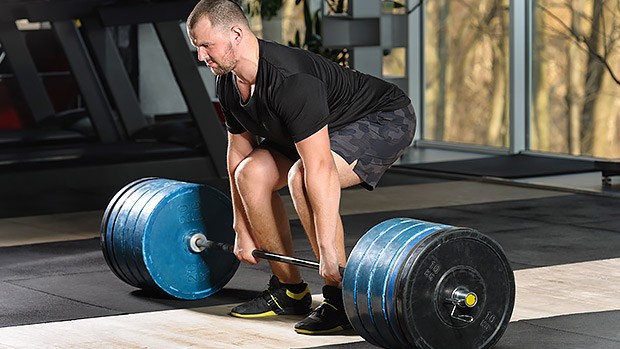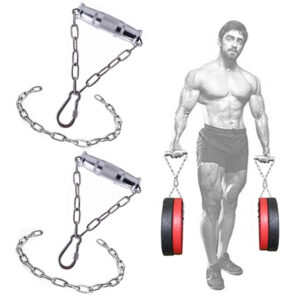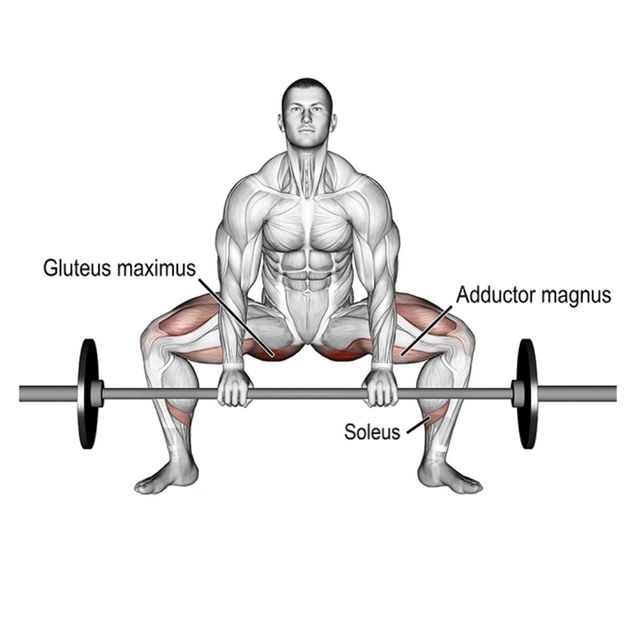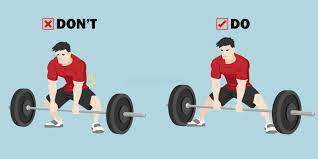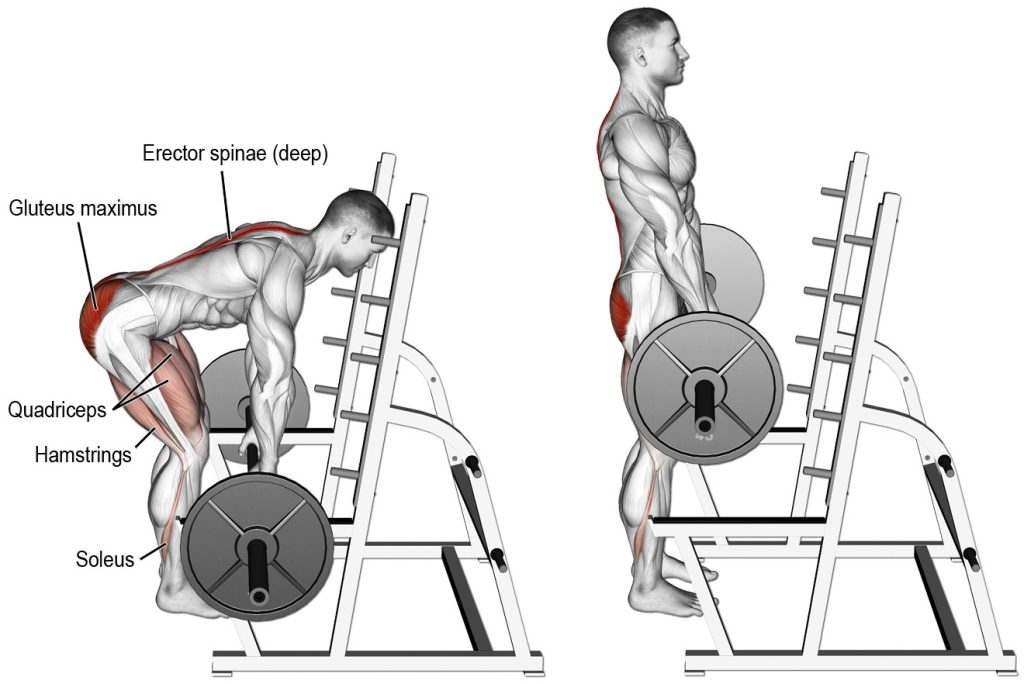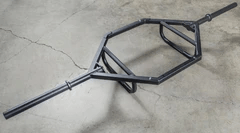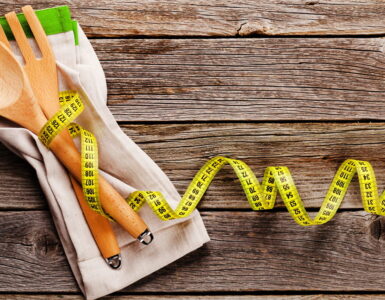Deadlifts…what’s dead about them? It’s a short term for dead weight lift, meaning the immovable weight on the floor and the person who lifts it up using muscles strength. Deadlifting as an exercise was started with the era of strongmen and, ever since then, has been part and parcel of every workout program. Endurance training, muscle mass building, weight training – get everything in one fell swoop. Let’s cut to the chase and discover together what types of deadlifts are the most beneficial and how many reps for deadlift are required for every workout.
Page Contents
The Deadlift
The deadlift is a weight training exercise with a loaded barbell or bar lifted off the ground to the level of the hips. It is one of the three powerlifting exercises, along with the bench press and squats. To perform the deadlifts effectively, you need some additional and supportive equipment:
-
Special clothing
Don’t wear ordinary shorts and t-shirts. The suit for weightlifting is made from very tight cloth. The critical advantage of tight-fitting clothing is that your body gets more support; it lifts pressure away from muscles and helps blood circulation [1]. Besides, your curves and muscles look better in tight workout clothes.
-
Wrist wraps
Supportive straps can also be used to provide support and joint stability. They can stabilize your arm during lifts and lower the soreness or pain that usually occurs among the lifters.
-
Chains and bands
They are used to increase or decrease resistance while lifting weights. With added resistance your body consumes more energy and burns more calories.
-
Shoes
An essential part of a kit provides support for the whole body [2]. When looking for shoes, don’t try to save money. Be sure to pay for good quality; it’s a part of your health. So, how do you choose the right shoes?
- The shoes must provide width and volume for your foot to fit into them. Otherwise, it will cut off blood flow which will cause extra fatigue and pain.
- The sole needs to “hug” your heels to prevent your foot from slipping and sliding. Opt for synthetic material, not leather, as it will not stretch out and has more breathable features.
- Single-strap shoes work fine, but shoes with two straps give stability.
Which Muscles Does The Deadlift Engage?
Deadlifting is a fundamental activity for athletes and weightlifters. It engages major muscle groups and trains your endurance. Let’s have a closer look at the muscles involved:
1. Back
Our back is mainly covered with the latissimus dorsi, rhomboids, and trapezius muscles (upper, middle, and lower parts), all under tension during the deadlift. Our back reinforces the proper positioning of the torso and posterior chain.
2. Hamstrings
The hamstrings participate in hip extension and are highly active in most deadlift patterns. Of course, some deadlift variations decrease hip flexion hence the hamstrings engagement. However, the hamstrings take part in the majority of movements.
3. Glutes
The glutes, gluteus maximus in particular, are responsible for extension during the deadlift. The glutes work together with the hamstrings and back muscles to perform the deadlift.
4. Erector Spinae
In other words, the lower back muscles assist the glutes, hamstrings, and upper back muscles in the deadlift. The erectors stabilize the spine and resist spinal flexion under load.
Step By Step Guidelines For Doing The Deadlift Correctly
Before you start the workout, make sure you follow the safety rules:
- Warm-up is a huge “must-do.” You need to prepare your body for active work. Otherwise, you may have a risk of having injuries.
- Stretch your legs to avoid muscle cramps.
- Don’t go for the heaviest weight from the start – nothing but injuries.
- Be in a safe, comfortable, and air-conditioned place.
Deadlift, in a nutshell, is pulling the weight up and down, which means you have muscle-growing and strength-building training and a chance to improve your heart work.
Deadlifting doesn’t tolerate half-measures – either do it properly or don’t even start. As long as extra weights are involved, you may have health problems if you don’t follow the procedure.
The procedure:
- Stand with the mid-foot under the barbell; end over and grab the bar with a shoulder-width grip.
- Bend your knees until your shins touch the bar; lift your chest up and straighten your lower back.
- Inhale and stand up with the weight.
- Hold the for a second at the top, with locked hips and knees.
- Return the weight to the floor, moving your hips back while bending your legs.
- Rest a second at the bottom and repeat.
Don’t round your spine because it puts uneven pressure on your spinal discs, injuring them.
The rep range for deadlifts starts with 2-3 sets of 4-5 reps. The first sets should be smooth, with average speed.
Deadlift Variations
Like many other exercises, the deadlift variations depend on your stance, muscles involved, and type of weights.
-
Sumo Deadlift
The sumo deadlift is a beginner variation to increase glute and back strength and improve athletic capacity. The sumo deadlift has a wider stance, which allows you to stay in a more upright position.
The procedure:
- Start with a bar loaded on the floor. Place your mid-feet so that the bar intersects them. The feet should be set very wide. Bend at the hips to grip the bar; relax the shoulders to lengthen your arms.
- Inhale, and lower your hips, keep your chest up. Push through the floor, extending your feet. Extend through the hips and knees.
- When the bar passes through the knees, lean back and drive the hips into the bar; pull your shoulder blades together.
- Return the weight to the ground by bending at the hips and controlling the weight.
Sumo deadlift sets and reps are individual. A novice shouldn’t start with 5 reps; take the time to adjust to this type of exercise.
-
Romanian (Stiff-Leg) Deadlift
Stiff leg deadlifts strengthen the posterior chain, benefit your lower back strength, hip flexion, and extension, and build muscle mass in your glutes and hamstrings. It is also an excellent exercise for your core if you keep it engaged throughout the training to avoid injury.
The procedure:
- Stand with the barbell in front of you, feet shoulder-width apart and in line with the bar.
- Keep your back straight, chest out, and shoulders back.
- Grab the bar outside the feet with an overhand grip (your palms face the body).
- Knees are in a slight bend.
- Push through the heels of the feet and extend the hips, bringing the bar up with you and keeping it close to the body, until you get to a neutral standing position.
- Hinge at the hips and control the bar back down to your starting position
-
Kickstand Deadlift
The kickstand deadlift targets the muscles of the hamstrings, glutes, and back. The kickstand position stretches and contracts each leg. This type of training is great for building lower body muscle mass.
The procedure:
- Holding a dumbbell in your hands in front of your hips; your feet are hip-width apart; your bodyweight is shifted to your left foot.
- Step your right foot 10 inches behind you, and rest your toes on the ground as a kickstand.
- Point your feet straight ahead, and slightly bend your back knee. Take a breath to stand tall, and as you exhale, engage your core.
- When you inhale, bend at your hips as you lower the dumbbells toward your left foot and keep the dumbbells close to your body. Lower the dumbbells until you feel a stretch in your left hamstring, but not pain.
- Keep your back flat throughout the entire movement.
- Exhale as you keep your back flat, engage your glutes, and stand up. This completes one rep.
Deadlift reps are 10 to 15 reps. Repeat on the other side.
-
Rack Pull
The rack pull is a fantastic exercise for developing your back muscles and gaining strength. It puts less strain on their joints and less stress on your lower back and hips than the traditional deadlift.
The procedure:
- Setting the arms of the rack at about knee height. Add your barbell to them.
- Set your feet shoulder-width apart and push your hips back.
- Grab the barbell with an overhand grip about shoulder-width apart.
- Engage your core; your back is flat, and your neck is aligned with the spine.
- Lift the bar, drive your hips forward and extend your knees
- Hold at the top, then lower back to the starting position
Keep performing for 2 – 5 sets of 5-10 repetitions. Remember, it’s an individual measure. High reps number is possible only when you’re strong enough.
-
Single-Leg Resistance Band Deadlift
A leg deadlift is an exercise that helps you develop your hip strength and work on your gluteus muscles, hamstrings, and Adductor Magnus.
The procedure:
- Place the band under your left foot and hold it with your left hand without stretching it.
- Lean forward and straighten your right leg, raising it until it is parallel to the ground.
- Squeeze your glute and lower your right leg while straightening your body. Stop when your right leg is about to touch the floor.
- Slowly return to the starting position. That’s 1 rep.
- Continue on the same side for 8 repetitions.
- Switch sides and repeat.
-
Sliding Deadlift (Gliding Deadlift)
Another beneficial exercise for building muscle mass and lower body strength.
The procedure:
- Hold a kettlebell in front of you and put the majority of your weight on your right heel.
- Slide the glider foot back toward a reverse lunge position.
- Keep your back straight, and brace your core.
- Without pausing, slide your leg back into a reverse lunge position.
If you wonder how many reps for deadlift are the best for you, start with 1-2 sets of 3-5 reps and see how it goes. The important thing is how your muscles react and how fast they adjust to the training. Once mastered, move on to more repetitions.
-
A Trap Bar Deadlift
A deadlift trap bar is a hexagonal-shaped barbell. You stand in the middle of the hexagon and perform the deadlift.
Some trap bars have two handles: one high and one low. Others have handles at the same height. Trap bar deadlifts make your workout less intense on the lower back but still engage multiple muscle groups. It’s suitable training for those who experience lower back problems.
The procedure:
- Step inside the bar, with your feet in line with the weight sleeves.
- Squat down.
- Grip the handles tightly on either side.
- Retract your shoulders back and down.
- Engage the core and lift the weight.
- Bring the hips forward and squeeze the glutes; do not hyperextend the spine.
How Many Reps For Deadlift?
The number of sets and reps for beginners will surely differ from those who are advanced. When building strength with the help of deadlifts, it’s essential to consider the following:
- How much training volume you do,
- The goals of your current workout,
- Individual preferences,
- Training experience,
- Physical ability to train.
You can build strength with any rep range on the deadlift.
- If you want to target max strength, deadlift sets and reps for beginners, include 1 to 8 reps per set.
- Deadlift sets and reps for strength training – 3 to 5 sets of 1 to 5 reps per workout;
- Deadlift reps for hypertrophy stick to 8 to 12 rep range. And keep in mind – your lower back and leg muscles should feel almost overloaded by the end of each 12 rep set.
- Deadlift sets and reps for weight loss – 15-20 reps of 3-5 deadlifts with loads can burn up to 40-60 calories.
-
Beginners😐
Deadlift reps and sets for beginners are the least demanding. If you are a beginner with deadlifts being the main compound of your workout, perform 2 – 3 sets of 5 – 6 reps each workout. Rest 90 seconds to 3 minutes between sets.
If you have no experience with workouts, start with 1 set of deadlifts 1–2 times weekly.
-
Intermediate👌
You may start improving your positions at this level because you already know the correct form and exercise properly. Your rep range may get higher, 5-8 sets of 7-9 reaps for each workout. You can also increase the weight as your muscles become more robust.
-
Advanced 💪
Your performance is top-notch by now; the muscles are used to different types of deadlifts, there’s a low chance of injury, and you may increase the intensity of the training.
At this point, you just increase the number of reps and set more and more. There are no limits, just your progress.
The Bottom Line
Taking all the information mentioned above, we understand that the benefits of deadlifts for our body are immense. If you thought of the best exercises for your workout routine, include deadlift reps. The deadlift works for your major muscle groups and makes you stronger, provided that you do it with a proper form.
If you keep wondering how many sets of deadlifts should I do or how many sets of deadlifts for mass weight loss need to perform, then consider some important things :
- The amount of time you spend in the gym – if you have a high reps range, you’re more likely to burn more calories and extra fat.
- Heavier weight puts more resistance and hence helps you consume more energy; however, there’s no need to rush. The beginners start with a lighter load to avoid injury.
- The number of sets for deadlifts is better to be planned according to your needs, weight, experience, and current fitness level. No general standard fits everyone; when you feel strong enough, go for heavier weights and more intensive training.
- Choose the variations that are the best for you.
Workouts are not easy and they will never be. If you have been struggling to start, it’s time to bite the bullet and go for your dreams! And we are always here for you if you need support or just a piece of friendly but expert advice.
FAQ
🏋️♂️How many sets should I do for deadlifts❓
🏋️♂️Is 5 reps enough for deadlifts❓
🏋️♂️Is 8 reps too much for deadlifts❓
🏋️♂️Should you go heavy on deadlifts❓
Sources:
- TIGHT OR LOOSE WORKOUT GEAR: WHICH IS BETTER
-
The Complete Science-Backed Guide to Lifting Shoes: Barefoot and Beyond

